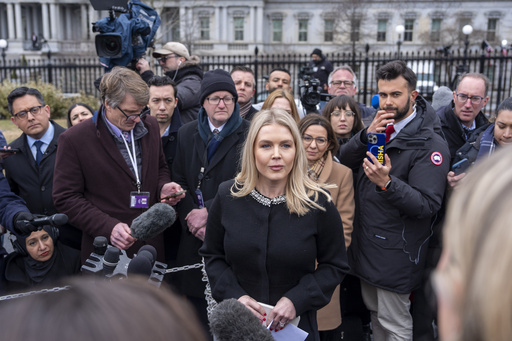President Donald Trump held an extended meeting with House Republicans at the White House on Thursday, creating an opportunity for lawmakers to resolve their differences regarding a significant multitrillion-dollar initiative aimed at reducing taxes, regulations, and government spending. The gathering lasted nearly five hours, during which Trump initially set the tone but then left the team to negotiate. This lengthy session resulted in Speaker Mike Johnson missing his scheduled meeting at the U.S. Capitol with Israeli Prime Minister Benjamin Netanyahu, who ended up speaking with Democratic leaders while Johnson’s office hurried to find a new time slot for their meeting.
Upon returning to the Capitol, Johnson remarked on the positive outcomes of the meeting, expressing gratitude toward Trump for guiding the discussion and facilitating cooperation among Republicans. Lawmakers from both the House and Senate have been looking to Trump for clarity on their budget proposals, but the President has been somewhat vague about specific details, instead urging Congress to finalize their plans.
The current deadlock has resulted in growing impatience among Republicans as they struggle to advance their main objectives with their party in power in Washington. This situation coincides with an influx of calls to Congress from constituents unhappy about Trump’s cost-cutting measures, which are promoted by billionaire Elon Musk and target federal programs and services.
House Republicans intended to continue their discussions late into the night to finalize an agreement that could be announced before the weekend recess. White House press secretary Karoline Leavitt indicated that the meeting revolved around the tax priorities of the Trump administration, including the potential elimination of federal taxation on tips, Social Security benefits, and overtime pay, as well as renewing tax cuts implemented in 2017.
Despite the slim majority in the House, Johnson insisted that Republicans would remain united in their efforts to pass the legislation by April. Rep. Jodey Arrington, the chair of the House Budget Committee, shared that his committee would hold hearings on the proposed package next week.
Rep. Lisa McClain, chair of the House GOP conference, described the meeting as “spirited,” noting that the discussions were intense at times. The group ended up getting lunch with turkey-bacon sandwiches while debating in the Cabinet Room for so long. Comparing the ongoing discussions to a relationship, McClain remarked that if the previous meeting with Trump had felt like a good first date, this one felt more like a discussion about future family plans.
As Johnson and the House members continue to lag behind in their schedule—initially hoping to start budget hearings this week—the Senate is making strides to take control of the budgeting process. GOP senators, led by Senate Majority Leader John Thune from South Dakota, will convene for their meeting at Trump’s Mar-a-Lago estate on Friday. They have advocated a two-pronged strategy, beginning with a smaller bill that allocates funds for Trump’s U.S.-Mexico border wall and deportation plans, before moving on to a larger package of tax break extensions ahead of year-end deadlines.
Sen. Lindsey Graham, chair of the Senate Budget Committee, announced that his segment will begin hearings next week, advancing the process. The contrasting approaches from the House and Senate are shaping up to be a competitive effort to achieve the GOP’s key objectives.
House Republicans desire what Trump has termed a “big, beautiful bill,” which would extend approximately $3 trillion in tax cuts that are set to expire at the year’s end alongside additional priorities, such as funding for the administration’s deportation initiative and border wall. This proposal also includes sweeping cuts to various government programs, ranging from healthcare to food assistance, to help balance the financial impact of the tax cuts.
The alternative smaller-scale proposal from Graham is roughly estimated at $300 billion and would include funding for border security and increased defense spending, primarily offset by cuts to green energy initiatives introduced during the Biden administration. Graham believes this plan would provide the necessary funds to complete the border wall and bolster Immigration and Customs Enforcement resources.
While House Republicans recognize the importance of Graham’s strategy, they face internal conflicts regarding their own proposals. Leadership is suggesting cuts that would achieve $1 trillion in overall savings over a decade; however, members from the conservative House Freedom Caucus are pushing for at least double that amount.
Rep. Chip Roy from Texas has expressed a desire for $2.5 trillion in spending cuts over ten years, aiming for a more substantial reduction compared to the leadership’s proposed figure. The Freedom Caucus sees Graham’s more limited approach as a preliminary step toward fulfilling the broader immigration and deportation initiatives from Trump, as lawmakers continue negotiations on the comprehensive tax and spending package.
Nonetheless, House Budget Committee chair Arrington previously indicated that achieving the extensive $2.5 trillion in cuts may be overly ambitious. Johnson requires strong support within his party to advance any legislation past a united Democratic front. On the Senate side, Republicans currently hold a slim majority, with minimal flexibility for dissenting voices.
Trump has often emphasized that he is more focused on the outcomes of proposed policies than the specific legislative hurdles encountered in Congress.



